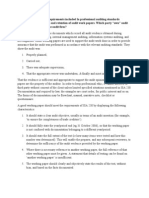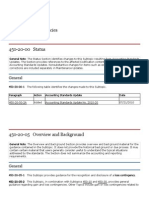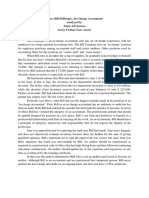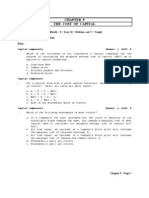ZZZZ Best Case Study
ZZZZ Best Case Study
Uploaded by
Novah Mae Begaso SamarCopyright:
Available Formats
ZZZZ Best Case Study
ZZZZ Best Case Study
Uploaded by
Novah Mae Begaso SamarOriginal Description:
Copyright
Available Formats
Share this document
Did you find this document useful?
Is this content inappropriate?
Copyright:
Available Formats
ZZZZ Best Case Study
ZZZZ Best Case Study
Uploaded by
Novah Mae Begaso SamarCopyright:
Available Formats
Samar, Novah Mae B. July 12, 2013 Diansay, Yra Dessa T.
BSA-4
1. SAS No. 106 Audit Evidence, identifies the principal management assertions that underlie a set of financial statements. The occurrence assertion was particularly critical for ZZZZ Bests insurance restoration contracts. ZZZZ Bests auditors obtained third-party confirmations to support the contracts, reviewed available documentation, performed analytical procedures to evaluate the reasonableness of the revenues recorded on the contracts, and visited selected restoration sites. Comment on the limitations of the evidence that these procedures provide with regard to the management assertion of occurrence.
Upon the performance of those procedures, the auditors of ZZZZ Best Inc. had obtained evidence in order to draw reasonable conclusions on which to base the audit opinion. However, these evidences are subject to limitations due to factors not controlled by the auditors. First limitation of the evidence is its insufficiency to support the occurrence, reliability and relevance of events and transactions. Mere paperwork is not enough to prove an event to have existed. It also needs inquiries from people accountable in recording or recognizing such events. Moreover, theres a risk in being dependent on evidences provided by the management itself. Auditors should ask cooperation from the third parties in order to verify all records. Second limitation is the rules implemented by the client which prohibit auditors to further inspect or review the financial standing of the company. Some clients make some arrangements with the auditors as to how wide their scope in auditing would be. As a result, auditors fail to uncover misstatements or manipulations in the financial statements. Third limitation is the consideration of the relationship between the cost of obtaining audit evidence and the usefulness of the information obtained. Theres a tradeoff between those two things that requires auditors to carefully evaluate them in order to get sufficient and reliable evidence.
2. In testimony of before Congress, George Greenspan reported that one method he used to audit the insurance restoration contracts was to verify that his client actually received payment on those jobs. How
such apparently reliable evidence lead an auditor to an improper conclusion?
Greenspan had been lead to an improper conclusion because he did not investigate the authenticity of the apparently reliable evidence. He may have verified that his client actually received payment on those jobs but he had committed lapse on determining the activities of the company in which those payments were used. He had been misled by the information given by the subordinate of Barry who had confirmed such payments and insurance restoration contracts which were actually bogus. Due to extreme concealments of fraud, he had come up to an improper conclusion.
3. Ernst and Whinney never issued an audit opinion on financial statements of ZZZZ Best but did issue a review report on the companys quarterly statements for the three months ended July 31, 1986. How does a review differ from an audit, particularly in terms of the level of assurance implied by the auditors report? Review of financial statements is one of the services being provided by auditors in which they are enabled to state whether anything has come to their attention that causes them to believe that the financial statements are not prepared in accordance with the financial reporting standard. Review of financial statements is only provided with limited evidence due to limited procedures allowed to be performed. It consists principally of inquiry and analytical procedures. As a result, this review engagement only provides moderate level of assurance that the information subject to review is free of material misstatements. On the other hand, in audit, a larger scope of procedures is performed, thus providing all possible evidence. Moreover, audit engagement allows the auditors to express an opinion as to the fairness of the financial statements, thus providing a high level or reasonable assurance. 4. What procedures, if any, do professional standards require auditors to perform when reviewing a clients pre-audit but post-year-end earnings press release?
To audit and to review are two different cases in terms of conducting its procedures. In auditing, there are specific audit procedures which will be determined by the auditor in order to arrive at opinion with reasonable assurance. In reviewing financial
statements, this involves inquiry and analytical procedures which only give limited assurance. Also, the professional standards do not necessarily require any procedures in reviewing a clients pre-audit but post-year-end earnings press release.
5. What is the purpose of predecessor-successor auditor communications? Which party, the predecessor or successor auditor, has the responsibility for initiating these communications? Briefly summarize the information that a successor auditor should obtain from the predecessor auditor.
A predecessor auditor is an auditor who has reported on the most recent audited nancial statements or was engaged to perform but did not complete an audit of the nancial statements, and has resigned, declined to stand for reappointment, or been notied that his or her services have been, or may be, terminated. The successor auditor is an auditor who is considering accepting or has already accepted an engagement to audit financial statements, but has not been in communication with the predecessor auditor. Communication between the predecessor and successor auditor is very important as it can yield important information as to whether or not the successor auditor should accept the engagement. There are many possible reasons why the predecessor auditor is no longer serving the client. Whether it was a disagreement on accounting principle, audit procedures, adequate disclosures, limiting the audit scope, or a multitude of other reasons, the successor auditor will need this information in order to make a decision. For this reason, it is the responsibility of the successor auditor to initiate communications with the predecessor auditor. This communication may be written or oral. By rule, auditors are not allowed to disclose confidential information discovered throughout the course of an audit, unless permitted in the Code of Professional Conduct. The potential client may allow the prospective auditor to fully respond to the successor auditors questions, but it is the responsibility of the successor auditor to ask for this permission, otherwise the successor auditor may not be able to obtain all of the pertinent facts. For the sake of efficiency, a successor auditor should make sure to inquire of the most important matters. Some of these may include: management integrity, disagreements between the predecessor auditor and management, any possible frauds or other illegal acts charged to the client, strength of internal controls, and the predecessor auditors opinion on the change of auditors.
6. Did the confidentiality agreement that Minkow required Ernst & Whinney to sign improperly limit the scope of the ZZZZ Best audit? Why or why not? Discuss general circumstances under which confidentiality concerns on the part of a client may properly affect audit planning decisions. At what point do client-imposed audit scope limitations affect the type of audit opinion issued?
The scope of an audit states that the audit is designed to obtain reasonable assurance of no material misstatements. It also requires that auditors discuss the audit evidence acquired and whether they believe the amount of evidence to be appropriate to express an opinion. As discussed earlier, E&W was required to sign a confidentiality agreement precluding them from contacting third parties with regards to ZZZZ Bests restoration projects. By signing this agreement, E&W effectively allowed ZZZZ Best to limit the scope of their audit. E&W was allowed to visit the restoration sites and view the contracts, but that was the extent of their audit on the contracts because of the agreement. Normally, the auditors may wish to gather more evidence and strengthen their faith in the validity of contracts by collaborating with independent parties, but this was disallowed. E&W was also not allowed to contact any insurance companies, contractors, or building owners involved with the restoration projects. This would force E&Ws auditors to issue a disclaimer of opinion, as they would not have been able to obtain reasonable assurance of no material misstatements, nor obtain sufficient audit evidence.
You might also like
- Research Report On General Ledger FraudDocument8 pagesResearch Report On General Ledger FraudAnupam KharatNo ratings yet
- Avon S CaseDocument4 pagesAvon S CaseReign EvansNo ratings yet
- Southeast Shoe Distributor 2006Document12 pagesSoutheast Shoe Distributor 2006Benny SuhendraNo ratings yet
- Auditing and Assurance Services 5th Edition Chapter One Solutions Chapter 1Document9 pagesAuditing and Assurance Services 5th Edition Chapter One Solutions Chapter 1wsvivi100% (3)
- Briefly describe the key requirements included In professional auditing standards regarding the preparation and retention of audit work papers. Which party “own” audit workpaper the client or the audit firm?Document3 pagesBriefly describe the key requirements included In professional auditing standards regarding the preparation and retention of audit work papers. Which party “own” audit workpaper the client or the audit firm?simson singawah100% (1)
- CBI Holding Company, Inc. / Case 2.6Document3 pagesCBI Holding Company, Inc. / Case 2.6octaevia50% (4)
- Ocean Manufacturing Inc. CaseDocument4 pagesOcean Manufacturing Inc. CaseHafizah MardiahNo ratings yet
- chp11 CaseDocument2 pageschp11 CaseSittie Ainna Acmed UnteNo ratings yet
- ZZZZ Best Company Inc SummaryDocument1 pageZZZZ Best Company Inc SummaryNovah Mae Begaso Samar100% (1)
- Case 1.11 New CenturyDocument12 pagesCase 1.11 New CenturyAlexa RodriguezNo ratings yet
- ZZZZ Best Company AnalysisDocument2 pagesZZZZ Best Company AnalysisJaz De VeraNo ratings yet
- Case 4.4Document4 pagesCase 4.4syafiraNo ratings yet
- Question 1Document2 pagesQuestion 1Doris WuNo ratings yet
- Summary of Leslie Fay Company StudyDocument5 pagesSummary of Leslie Fay Company StudyMhelka TiodiancoNo ratings yet
- MCS Chapter 2 - Case AnalysisDocument3 pagesMCS Chapter 2 - Case AnalysisKevin Wijaya100% (1)
- ASC 450 20 Loss Contingencies OrigDocument54 pagesASC 450 20 Loss Contingencies OrigBolsheviceNo ratings yet
- Group 1 - Case 1.5Document7 pagesGroup 1 - Case 1.5lumiradut70100% (3)
- Audit Case Study 3Document2 pagesAudit Case Study 3Novah Mae Begaso SamarNo ratings yet
- Sarboox ScooterDocument6 pagesSarboox ScooterNisa Surianto100% (1)
- Case Study - NextCard Inc.Document3 pagesCase Study - NextCard Inc.Juan Rafael Fernandez0% (1)
- CASE 2 3 RoughDocument4 pagesCASE 2 3 RoughHeni OktaviantiNo ratings yet
- Leslie FayDocument6 pagesLeslie FayNovah Mae Begaso Samar100% (2)
- Revenue and Cash Receipts CycleDocument5 pagesRevenue and Cash Receipts CycleFemmie SantiagoNo ratings yet
- Johnstone - 9e - Auditing - Chapter 10 - PPT FINALDocument93 pagesJohnstone - 9e - Auditing - Chapter 10 - PPT FINALNurlinaEzzati0% (1)
- Bill DeBurgerDocument4 pagesBill DeBurgerTatag Adi Sasono50% (2)
- Case 3Document4 pagesCase 3Bradley Warren100% (1)
- ACC200 Tuturial Sem 3 2019 PDFDocument74 pagesACC200 Tuturial Sem 3 2019 PDFanon_255678422100% (1)
- PA503 Chapter 6 Audit EvidenceDocument6 pagesPA503 Chapter 6 Audit EvidenceAnonymous rJuerZMVNo ratings yet
- Case 5.5 & 6.4Document8 pagesCase 5.5 & 6.4Mitchie Celeste100% (2)
- Case 5.3Document6 pagesCase 5.3Annisa Kurnia0% (1)
- Audit Chapter 08Document32 pagesAudit Chapter 08ying peiNo ratings yet
- Case 2.3 HanauerDocument10 pagesCase 2.3 HanauerAlexa RodriguezNo ratings yet
- Chapter 12 Audit of General Insurance Companies PMDocument11 pagesChapter 12 Audit of General Insurance Companies PMforevapure_bar88162No ratings yet
- Arens Solution Manual Chapter 7Document43 pagesArens Solution Manual Chapter 7Rizal Pandu NugrohoNo ratings yet
- Chapter 22 ArensDocument12 pagesChapter 22 Arensrahmatika yaniNo ratings yet
- Chapter 25 AnswerDocument6 pagesChapter 25 AnswerMjVerbaNo ratings yet
- Aicpa Aud Moderate2015Document25 pagesAicpa Aud Moderate2015King MercadoNo ratings yet
- The Fraud Tree and Its InvestigationDocument12 pagesThe Fraud Tree and Its Investigationfaisol_ridwan0% (1)
- Cash and Bank AuditDocument9 pagesCash and Bank Auditzeebee17No ratings yet
- Acc 412 Case 3 5 Goodner Brothers Inc 1Document6 pagesAcc 412 Case 3 5 Goodner Brothers Inc 1mrreza85No ratings yet
- Chapter 10Document12 pagesChapter 10jas02h1No ratings yet
- Case 2aDocument3 pagesCase 2a侯燕颉100% (1)
- Case 1.2 ESM Government Securities IncDocument14 pagesCase 1.2 ESM Government Securities IncAlexa RodriguezNo ratings yet
- Recognizing The Symptoms of FraudDocument12 pagesRecognizing The Symptoms of FraudlieselenaNo ratings yet
- Chapter 11 SolutionsDocument5 pagesChapter 11 Solutionssoozbooz100% (2)
- Case 4 - Exercise 4-2 (A) Internal Control - Preliminary AnalysisDocument2 pagesCase 4 - Exercise 4-2 (A) Internal Control - Preliminary Analysisjaneeta mathewNo ratings yet
- 4 Cressey - Criminal Violation of Financial TrustDocument7 pages4 Cressey - Criminal Violation of Financial TrustNovitaNo ratings yet
- Insurance AuditDocument33 pagesInsurance AuditAkshada ChitnisNo ratings yet
- Tugas Auditing 1 Pertanyaan Dan Soal Diskusi No 14-30 Sampai 14-32 14-30 (Objective 14-5) You Have Been Asked by The Board of Trustees of A Local ChurchDocument4 pagesTugas Auditing 1 Pertanyaan Dan Soal Diskusi No 14-30 Sampai 14-32 14-30 (Objective 14-5) You Have Been Asked by The Board of Trustees of A Local ChurchHusnul KhatimahNo ratings yet
- 1st Chapter AssuranceDocument5 pages1st Chapter AssuranceRashed AliNo ratings yet
- Anderson and Zinder, P.C., CpasDocument3 pagesAnderson and Zinder, P.C., CpasJack BurtonNo ratings yet
- Audit Risk and MaterialityDocument5 pagesAudit Risk and Materialitycharmsonin12No ratings yet
- Case 9.1ZZZZ OriginalDocument3 pagesCase 9.1ZZZZ OriginalIan ChenNo ratings yet
- Review and Audit AssuranceDocument6 pagesReview and Audit AssuranceReg DungcaNo ratings yet
- Introduction To Financial Statement AuditDocument63 pagesIntroduction To Financial Statement AuditRica RegorisNo ratings yet
- Day 2 & 3 Inter 24 BookDocument7 pagesDay 2 & 3 Inter 24 BookPrince ManglaNo ratings yet
- Case 2Document7 pagesCase 2sulthanhakimNo ratings yet
- Audit_I_Ch._IIIDocument11 pagesAudit_I_Ch._IIItsedenyayordanosNo ratings yet
- Compiled by Daisy B. Medina-Cruz, CPA, MBA: Week 8 Assignment/Quiz The Financial Statement Audit ProcessDocument8 pagesCompiled by Daisy B. Medina-Cruz, CPA, MBA: Week 8 Assignment/Quiz The Financial Statement Audit ProcessAngelica Mae MarquezNo ratings yet
- Assurance&Non Assurance EngagementsDocument17 pagesAssurance&Non Assurance EngagementsInspire xxNo ratings yet
- ACCO 30043 Assignment No.3Document8 pagesACCO 30043 Assignment No.3RoseanneNo ratings yet
- The Budget Process & The CongressDocument7 pagesThe Budget Process & The CongressNovah Mae Begaso SamarNo ratings yet
- Contribution Overall Riskiness of The Portfolio Beta CoefficientDocument3 pagesContribution Overall Riskiness of The Portfolio Beta CoefficientNovah Mae Begaso SamarNo ratings yet
- Samar, Novah Mae B. (Resume)Document2 pagesSamar, Novah Mae B. (Resume)Novah Mae Begaso SamarNo ratings yet
- TB Chapter09Document57 pagesTB Chapter09Vina 비나 Pedro100% (4)
- A424: Chapter 6 Audit Responsibilities and Objectives Preparation QuestionsDocument8 pagesA424: Chapter 6 Audit Responsibilities and Objectives Preparation QuestionsNovah Mae Begaso SamarNo ratings yet
- Auditing Theory: Enron Case StudyDocument1 pageAuditing Theory: Enron Case StudyYra DiansayNo ratings yet
- AU 00315 Predecessor SuccessorDocument8 pagesAU 00315 Predecessor SuccessorNovah Mae Begaso SamarNo ratings yet
- Case Study: F&C International, IncDocument1 pageCase Study: F&C International, IncNovah Mae Begaso Samar100% (1)
- Leslie FayDocument6 pagesLeslie FayNovah Mae Begaso Samar100% (2)
- Triton CaseDocument6 pagesTriton CaseNovah Mae Begaso SamarNo ratings yet
- Chapter 13Document14 pagesChapter 13Novah Mae Begaso SamarNo ratings yet
- Bill of RightsDocument3 pagesBill of RightsNovah Mae Begaso SamarNo ratings yet
- Chapter 2Document16 pagesChapter 2Novah Mae Begaso SamarNo ratings yet
- The Guiding Principles of My Life: Novah Mae Samarbsa-3 July 5, 2012Document1 pageThe Guiding Principles of My Life: Novah Mae Samarbsa-3 July 5, 2012Novah Mae Begaso SamarNo ratings yet
- Consolacion L. FajardoDocument26 pagesConsolacion L. FajardoNovah Mae Begaso SamarNo ratings yet
- False CauseDocument8 pagesFalse CauseNovah Mae Begaso SamarNo ratings yet











































































